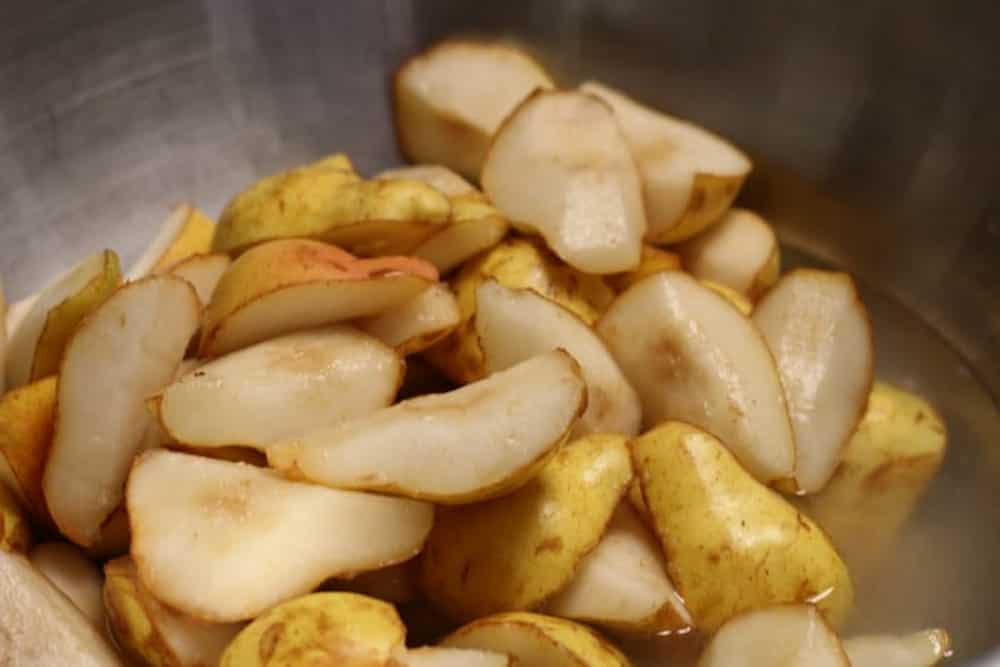Can canned pears be easily metabolized by the human body? The answer is yes. Because this canned fruit has lots of fiber and it’s easy to digest. If you’re craving something sweet but also want to do something good for your digestive system, chewing on pear is a great option.
The high fiber content of pears suggests that eating them may greatly benefit intestinal health. Constipation is avoided and gut health is preserved thanks to the fermentation process that certain forms of fiber undergo.
Despite its numerous benefits, eating pears may cause gastrointestinal problems in fructose-intolerant persons. The 5.5 grams of fiber in a medium-sized, fresh pear is comparable to 22 percent of the daily requirement for fiber if your calorie intake is 2,000.
Fiber adds both volume and heaviness to feces because it dissolves in the gut to form a gel with the water there. The risk of constipation is lowered as a result of the improved bowel movement that results from this.

Soluble fiber, one of the two types of fiber, may also help prevent diarrhea because of its ability to absorb water. It’s important to remember that consuming too much fiber at once might have the opposite effect and cause diarrhea. The digestive tract often has less trouble processing low-fiber foods.
Unfortunately, despite its importance, your body may be unable to break down the fiber found in plant foods like fruits, vegetables, and grains.
This causes the fiber to move through your large intestine, which may lead to uncomfortable symptoms including gas, bloating, and constipation. Consuming foods low in fiber may assist decrease the amount of food that is unable to be broken down in the digestive process, which in turn can alleviate some of the symptoms.
Fruits with high amounts of fiber while whole still become considerably easier to digest after being cooked due to the fiber being broken down significantly. The skin and seeds of fruits and vegetables may be removed to lower their fiber content.
As with any raw food, moderation is key when eating any of the aforementioned fruits; overconsumption may still lead to stomach distress. Like entire fruits, whole vegetables are an excellent source of fiber.
Cooking softens the fiber so that it’s easier to digest. Your local grocery store should have both fresh and canned vegetables for you to pick from when deciding how to prepare them. Tomato sauces and roasted potatoes without the skin are two more options for low-fiber vegetables. Low-fiber, low-calorie fruit and vegetable juices are the result of straining off the pulp.

Dishes with lean meats like chicken, turkey, or fish tend to be more well-received by diners since they are simpler to digest. Lean slices of beef or pig, as well as ground meats, are another tasty option.
Vegetarians may obtain enough protein from eggs, creamy nut butter, and tofu. The ease with which a person digests meat may also depend on how the meat is cooked. Instead of frying it, you may try grilling, broiling, baking, or poaching it. You may have heard that a diet rich in hearty whole grains is the best thing you can do for your health.
White bread, refined rolls, plain bagels, white toast, and white crackers are your best choices when looking for grains that are easy to digest. Additionally, you may get dry or cooked cereals with less fiber content at the supermarket.
It’s conceivable that your stomach will react better to processed cookies if they don’t include any nuts or dried fruit.
Simple pasta and noodles, refined wheat pretzels, and other similar foods fall within this group. Refined flour and other grains are easier on the digestive system since the bran and germ have been eliminated. Unrefined flours, on the other hand, have more fiber and are processed less than their refined counterparts.
Maintaining a healthy weight often does not recommend ingesting large quantities of refined flour. If you suffer from lactose intolerance, dairy products may give you tummy troubles or even induce diarrhea. Try to find items with no lactose or very little lactose in them. The low fiber content of dairy products, on the other hand, may make them easy to digest for certain people.
You might consume milk in its purest form by drinking it or eating dairy products like cheese, yogurt, or cottage cheese. It’s not easy to break down a meal of ice cream or other high-fat dairy products. Herbs and spices need careful handling when used in the kitchen.

It might be challenging to absorb whole spices. It should be OK to use ground variety. Dishes that are hot or that include a lot of chili pepper may cause stomach discomfort and acid reflux in certain people. It may also help digestion if you consume by cutting food into little pieces and chewing it carefully before swallowing.
This rule applies to all of your meals. Don’t eat hastily; instead, schedule enough time for each meal. You may notice fewer frequent bowel motions and smaller than usual stools if you eat a diet low in fiber. Maintaining regular bowel movements may be achieved by drinking enough fluids, particularly water and herbal tea. Meals rich in fiber content are at the opposite end of the spectrum.
It’s possible that fried foods, as well as fiber, are to blame for stomach upset. Caffeine, carbonation, and food that’s too spicy for the individual’s palate might all be troublesome. Here are some meals to avoid since they may cause digestive problems.
Most whole fruits, especially those that retain their skins or seeds, have a good amount of fiber. Fruits like bananas and avocados are often well tolerated by the digestive system. Don’t waste your time or health on blended fruit or vegetable drinks that include pulp.
Those who suffer from gastroesophageal reflux illness may have trouble digesting tomatoes and citrus fruits (GERD). Some people may not like pickles, kimchi, or sauerkraut for various reasons.
Consuming fermented foods may improve digestion, but only if doing so does not cause any discomfort. This is because “friendly” microorganisms like probiotics and helpful digesting enzymes are present in certain commercially available brands of these foods and homemade versions of them.
These beneficial bacteria do preliminary digestion of the food, facilitating better nutrient absorption. Make sure you read labels on commercial products to ensure they have the right number of probiotics and other beneficial bacteria and that they don’t have too much salt or sugar. Most refined grains are easily digested. This suggests that whole-grain varieties of bread, rolls, and bagels are not necessarily the healthiest choices.
Be on the lookout for multigrain crackers, cereal, and other grain products that feature raisins, almonds, and seeds as ingredients. You should also avoid breakfast cereals since they are often high in calories, particularly those that include nuts, dried fruits, and bran.

Some people also have trouble digesting whole grain products like granola, brown rice, wild rice, and pasta. If you have lactose intolerance, you definitely shouldn’t eat most dairy products. However, you may be able to eat yogurt or kefir.
These foods are easier to digest because they include probiotic microorganisms that break down lactose sugar.
If you want to consume more probiotics, you may either make your yogurt or look for brands that have been designed to do so. You should also stay away from any dairy items that include artificial sweeteners, fresh fruit, seeds, or nuts.
Changes to your diet of this magnitude need a consultation with your primary care physician or a registered dietitian. Before entirely cutting out foods that may cause digestive issues, keeping a diet diary may be helpful. Keep a food journal and record when you ate, what you ate, and how you felt after eating.
In this approach, you may pinpoint the foods that trigger your stomach discomfort, gas, or other unpleasant symptoms, and avoid them in the future. You may also share this with your doctor to help with the evaluation of any health issues you may be having.

Sagharcanned company has a long history to produce different types of canned foods, fruits, vegetables, meats, and caviar in the international market. If you want to get high-quality canned goods, visit our website and choose your favorite one.

Your comment submitted.